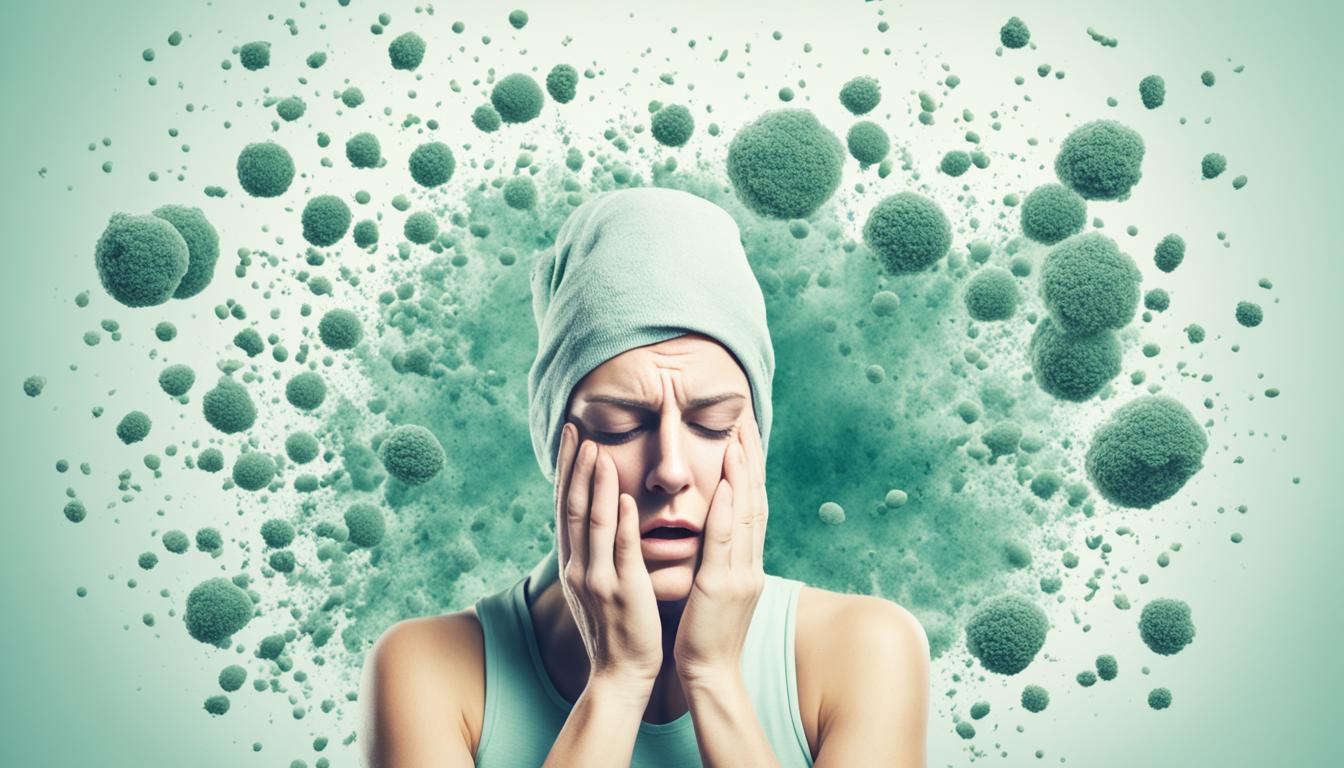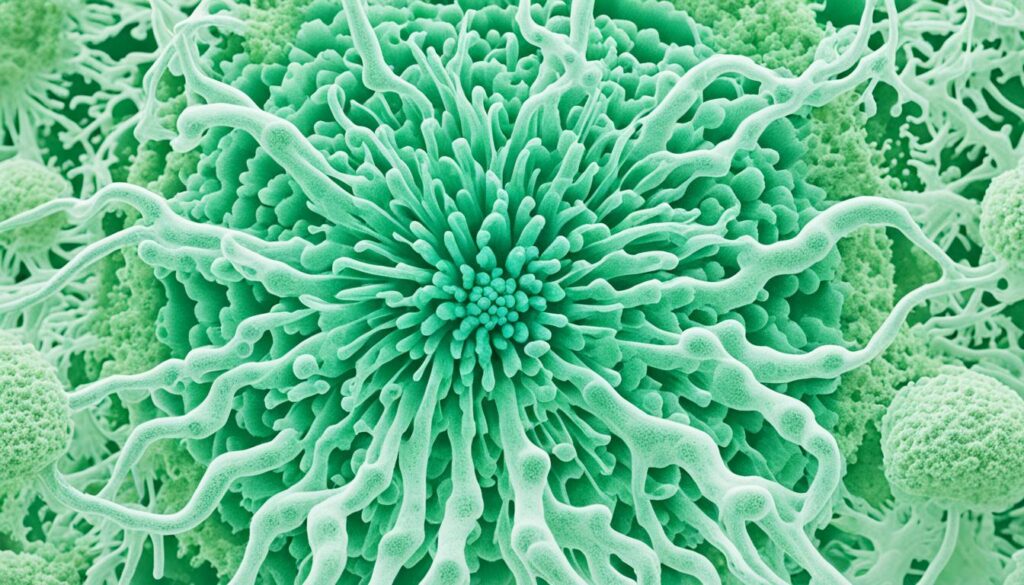
Understanding Symptoms of Mold Toxicity Effectively
In this article, we will explore the symptoms of mold toxicity and the importance of understanding them in order to protect your health. Mold toxicity, also known as mold illness, can have a significant impact on your well-being if left unaddressed. By recognizing the signs of mold toxicity, you can take the necessary steps to mitigate its effects and safeguard your overall health.
Key Takeaways:
- Understanding the symptoms of mold toxicity is crucial for protecting your health.
- Common symptoms of mold toxicity can range from mild to severe and may affect different systems in the body.
- Recognizing specific signs of mold illness can help with accurate diagnosis and treatment.
- Mold spore exposure can trigger allergic reactions and respiratory issues in susceptible individuals.
- Black mold, a dangerous type of mold, can have severe health effects and should be addressed immediately.
Common Symptoms of Mold Toxicity
Exposure to mold can have a wide range of symptoms on the human body. It’s important to be aware of these common symptoms in order to recognize and address potential mold toxicity. The severity of symptoms can vary from mild to severe, depending on factors such as the type of mold and individual sensitivity levels.
Here are some common symptoms of mold toxicity:
- Respiratory issues: Mold exposure can often cause respiratory symptoms such as coughing, wheezing, and shortness of breath. Individuals may experience increased congestion, sinusitis, or a persistent sore throat.
- Allergic reactions: Mold can trigger allergic reactions in susceptible individuals. Symptoms may include sneezing, itching, watery eyes, and skin rashes.
- Unexplained fatigue: Mold toxicity can lead to chronic fatigue, leaving individuals feeling tired and lacking energy despite adequate rest.
- Headaches and migraines: Many people exposed to mold report frequent headaches or migraines that seem to have no apparent cause.
- Neurological symptoms: Mold toxicity can affect the central nervous system, leading to symptoms like brain fog, difficulty concentrating, memory problems, and mood swings.
- Gastrointestinal issues: Some individuals may experience digestive problems such as nausea, abdominal pain, diarrhea, or vomiting as a result of mold exposure.
It’s important to remember that these symptoms can vary from person to person. Some individuals may only experience mild symptoms, while others may have more severe reactions. If you suspect mold toxicity, consulting a healthcare professional is crucial for proper evaluation and treatment.
Proactive Steps to Mitigate Mold Toxicity Symptoms
To reduce the symptoms associated with mold toxicity, it’s essential to take proactive measures to minimize exposure. Here are some steps you can take:
- Identify and address sources of moisture in your home, as mold thrives in damp environments.
- Ensure proper ventilation in bathrooms, kitchens, and high-moisture areas to prevent mold growth.
- Regularly clean and dry areas prone to mold, such as bathrooms, basements, and air conditioning units.
- Use mold-resistant materials in construction and renovation projects.
- Invest in high-quality air purifiers that can effectively filter mold spores from the air.
Taking these preventive measures can help reduce the risk of mold exposure and alleviate symptoms of mold toxicity.
Remember, if you suspect mold toxicity and experience persistent symptoms, it’s important to consult with a healthcare professional for accurate diagnosis and treatment. Prompt action can help you regain control of your health and well-being.
Recognizing Signs of Mold Illness
When it comes to mold exposure, recognizing the signs of mold illness is crucial for proper diagnosis and treatment. Mold illness refers to a range of health issues that can arise from exposure to mold. While some symptoms may overlap with general mold toxicity, there are specific signs that indicate a deeper level of mold-related health concerns.
One of the key signs of mold illness is chronic fatigue. Individuals experiencing mold illness often feel excessively tired, lacking energy even after a full night’s sleep. This persistent fatigue can significantly impact daily life and productivity.
Brain fog is another common symptom of mold illness. It refers to difficulty concentrating, memory problems, and overall cognitive impairment. These cognitive issues can be frustrating and affect work performance and daily tasks.
Mold illness can also manifest as respiratory problems. Coughing, wheezing, shortness of breath, and sinus congestion are indications of mold-related respiratory distress. These symptoms may worsen when in mold-contaminated environments.
Individuals experiencing mold illness may also suffer from headaches and migraines. These headaches can be intense and debilitating, affecting the quality of life and overall well-being.
In some cases, mold illness can lead to gastrointestinal issues such as nausea, vomiting, and diarrhea. These symptoms may occur after ingestion of mold-contaminated food or inhalation of mold spores.
The signs of mold illness are distinct from general mold toxicity symptoms. It is essential to recognize and differentiate these signs to ensure proper diagnosis and effective treatment.
Early detection of mold illness is crucial for preventing further health complications. If you suspect mold exposure or experience any of the above symptoms, consult a healthcare professional for a thorough evaluation. They can recommend appropriate diagnostic tests and treatment options to address mold-related health concerns.

Do not ignore the signs of mold illness. Take proactive steps to protect your health and create a mold-free environment.
Identifying Mold Spore Exposure Symptoms
When it comes to mold toxicity, exposure to mold spores can have a significant impact on your health. Mold spores are tiny airborne particles that can be inhaled and trigger various symptoms, especially in individuals who are susceptible to mold-related allergies or have respiratory conditions.
If you suspect mold spore exposure in your environment, it’s crucial to be able to identify the symptoms associated with it. Recognizing these symptoms can help you take the necessary steps to address the mold issue and protect your well-being.
Here are some common mold spore exposure symptoms:
- Allergic reactions: Mold spores can act as allergens, leading to symptoms such as nasal congestion, sneezing, coughing, itchy eyes, and throat irritation.
- Respiratory issues: Inhaling mold spores can trigger or worsen respiratory conditions, causing chest tightness, wheezing, shortness of breath, and asthma attacks.
- Skin irritations: Some individuals may experience skin rashes, itching, or redness upon contact with mold spores.
- Headaches and fatigue: Exposure to mold spores can result in persistent headaches and a general feeling of fatigue and lethargy.
If you notice these symptoms persisting or worsening when you are in a particular environment, it could be a sign of mold spore exposure. It is crucial to consult with a medical professional for a proper diagnosis and discuss possible remediation methods to eliminate the mold.
Minimizing Mold Spore Exposure
Preventing mold spore exposure is essential for maintaining a healthy living or working environment. Here are some steps you can take to minimize the risk:
- Keep humidity levels in check: Mold thrives in damp environments, so make sure to maintain indoor humidity levels between 30-50%.
- Address water leaks promptly: Leaky pipes or roofs can create moisture issues that contribute to mold growth. Address any leaks as soon as possible.
- Promote proper ventilation: Ensure proper air circulation by using exhaust fans in bathrooms and kitchens and opening windows when weather permits.
- Regularly clean and dry affected areas: Pay attention to areas prone to moisture, such as bathrooms and basements, and clean and dry them thoroughly.
- Consider air purifiers: HEPA filters can help reduce the number of mold spores in the air, especially in areas with known mold problems.
By being aware of the symptoms associated with mold spore exposure and taking proactive measures to minimize the risk, you can help create a healthier living or working environment for yourself and others.

Dealing with Black Mold Symptoms
Black mold, also known as Stachybotrys chartarum, is a particularly dangerous type of mold that can have severe health effects. Exposure to black mold can lead to various symptoms, including:
- Respiratory issues, such as coughing, wheezing, and shortness of breath.
- Allergic reactions, such as sneezing, runny nose, and itchy eyes.
- Headaches and migraines.
- Fatigue and weakness.
- Skin rashes and irritation.
If you suspect black mold in your home or workplace, it is crucial to take immediate action. Ignoring black mold can worsen symptoms and pose serious health risks. Here are the steps you should follow:
- Identify the source: Look for signs of water damage, such as leaks or flooding. Black mold often thrives in damp and humid environments.
- Consult a professional: Reach out to a reputable mold remediation specialist, like Mold Busters, for a thorough inspection and accurate assessment of the mold problem.
- Mold remediation: If black mold is confirmed, professional mold remediation is essential. Do not attempt to remove the mold yourself, as it can release harmful spores into the air, exacerbating the problem.
- Protective measures: During the remediation process, it’s crucial to wear protective gear, including masks and gloves, to minimize your exposure to mold spores.
- Prevention: After the mold is removed, take measures to prevent future mold growth, such as addressing any water leakage issues, improving ventilation, and keeping indoor humidity levels low.
Remember, black mold symptoms should never be ignored. If you experience persistent or severe symptoms, seek medical attention promptly. Treating the underlying cause of your symptoms is crucial for your health and well-being.
Safeguard Your Health with Professional Mold Remediation
“Mold is not something to take lightly, especially black mold. It can pose serious health risks and compromise the integrity of your property. Don’t delay in addressing the problem and seek professional assistance for effective mold remediation.”
– Dr. Emily Roberts, Environmental Health Specialist
Conclusion
In conclusion, understanding and recognizing the symptoms of mold toxicity is crucial for safeguarding your health. Mold exposure can lead to a range of symptoms, including respiratory issues, allergic reactions, and general illness. By familiarizing yourself with the common signs of mold toxicity, you can take proactive steps to address the problem.
It is important to seek professional assistance when dealing with mold issues. Companies like Fix Mold Miami specialize in mold assessments, prevention, and remediation. Their experts can provide thorough assessments of your property, implement effective prevention measures, and undertake professional mold remediation to ensure a safe and healthy living environment.
If you suspect mold toxicity or black mold in your home or workplace, it is essential to act promptly. Contact the professionals at Fix Mold Miami at 305-465-6653 for expert advice and assistance. Remember, early intervention can help mitigate the risks and prevent further health complications. Don’t wait, take action today!




